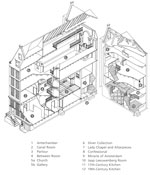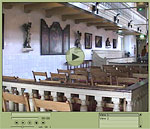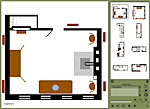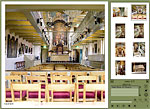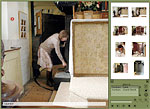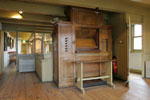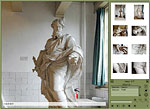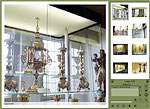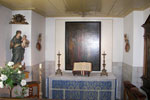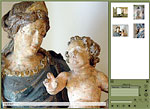Our Lord in the Attic: A Case Study
Church
Cross section of the main house and the house at the back.
![]() Floor plans (PDF, 2.1MB)
Floor plans (PDF, 2.1MB)
![]() 'Description of area' database (PDF, 664KB)
'Description of area' database (PDF, 664KB)
![]() Database area reference key (XLS, 571KB)
Database area reference key (XLS, 571KB)
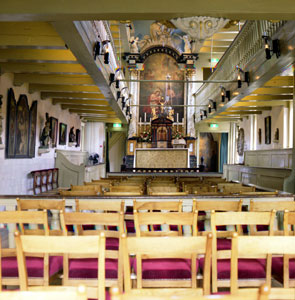 The church is the museum’s centerpiece: a secret Catholic place of worship, the only one of its kind still practically in its original state. The church in the attic is the most extraordinary part of the museum. It was built by Jan Hartman from 1661-1663 in the top stories of the three adjacent buildings. Its present appearance dates from the second quarter of the eighteenth century, when the second gallery was extended, and the new altar was brought forward.
The church is the museum’s centerpiece: a secret Catholic place of worship, the only one of its kind still practically in its original state. The church in the attic is the most extraordinary part of the museum. It was built by Jan Hartman from 1661-1663 in the top stories of the three adjacent buildings. Its present appearance dates from the second quarter of the eighteenth century, when the second gallery was extended, and the new altar was brought forward.
Video: Two views of the Church
Launch image viewer of floor plans
Launch image viewer of the main floor of the church
Launch image viewer of Church furniture
Description of the church
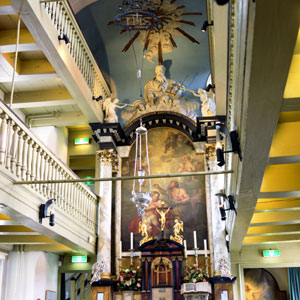 The focal point of the church is the Baroque altar (c. 1715). An illusion of space is created by a combination of architecture, sculpture and painting. The eye is led naturally from Jacob de Wit’s altarpiece showing the Baptism of Christ by John the Baptist up to the stucco of God the Father and the Holy Spirit, portrayed as a dove.
The altar piece was painted around 50 years after the attic church was established. Because the design for this altarpiece is dated 1716 and also gives the name of the resident priest at the time, Van Schayck, it can safely be asserted that the Baptism of Christ in the Jordan was made specifically for this church. The date also reveals that this was the first altarpiece De Wit painted for a Catholic church in Amsterdam following his apprenticeship in Antwerp. As was common in 17th and 18th century churches, this church has several paintings for above the altar. This allowed them to be exchanged appropriate to different times of the year: Christmas, Easter and Whit sun each had a particular subject. The attic church had four interchangeable alter paintings, three of which have been preserved. Besides the Baptism of Christ, these depict the Resurrection of Christ ‑ the altarpiece displayed at Easter - and the Descent of the Holy Spirit, for Whit sun. The original fourth altarpiece showing the Crucifixion was lost. Recently, however, the museum purchased a replacement for this fourth altarpiece. The Crucifixion, painted by Johannes Voorhout (1647‑1723) of Amsterdam in 1676, depicts the Virgin Mary and St John standing and Mary Magdalene kneeling. The three altar pieces are displayed in the room just behind the altar, adjacent to the Lady chapel.
The focal point of the church is the Baroque altar (c. 1715). An illusion of space is created by a combination of architecture, sculpture and painting. The eye is led naturally from Jacob de Wit’s altarpiece showing the Baptism of Christ by John the Baptist up to the stucco of God the Father and the Holy Spirit, portrayed as a dove.
The altar piece was painted around 50 years after the attic church was established. Because the design for this altarpiece is dated 1716 and also gives the name of the resident priest at the time, Van Schayck, it can safely be asserted that the Baptism of Christ in the Jordan was made specifically for this church. The date also reveals that this was the first altarpiece De Wit painted for a Catholic church in Amsterdam following his apprenticeship in Antwerp. As was common in 17th and 18th century churches, this church has several paintings for above the altar. This allowed them to be exchanged appropriate to different times of the year: Christmas, Easter and Whit sun each had a particular subject. The attic church had four interchangeable alter paintings, three of which have been preserved. Besides the Baptism of Christ, these depict the Resurrection of Christ ‑ the altarpiece displayed at Easter - and the Descent of the Holy Spirit, for Whit sun. The original fourth altarpiece showing the Crucifixion was lost. Recently, however, the museum purchased a replacement for this fourth altarpiece. The Crucifixion, painted by Johannes Voorhout (1647‑1723) of Amsterdam in 1676, depicts the Virgin Mary and St John standing and Mary Magdalene kneeling. The three altar pieces are displayed in the room just behind the altar, adjacent to the Lady chapel.
At the top, the altar culminates in stucco sculptures representing God the Father and the Holy Spirit surrounded by clouds and cherubs. Together with the altarpiece depicting the Son, the combination portrays the Holy Trinity.
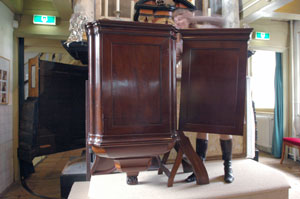 |
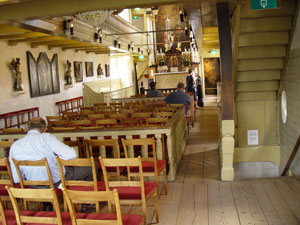 |
As space in the church had to be utilized efficiently, a clever mechanism was employed for a movable pulpit, which is stored in a cupboard fitted in the left column of the altar. The pulpit is made of mahogany, like the early nineteenth-century communion bench in front of the altar. The cupboard where it is normally stored is painted on the outside to resemble marble. The pulpit is swung into place in front of the altar by a two step movement, in which the difference in height between starting point and finish is ingeniously compensated for by a mechanical system of metal rails and hinges. Until 1999, the pulpit was shown twice a day and was used for every mass. Today the pulpit is considered too delicate for regular use and is almost never shown - it is used for Christmas mass only.
The church could ‘seat’ (in the early days there were no chairs) 150 people and was traditionally divided into sections to accommodate the different status of its congregation. On either side of the church, near to the altar, were the fixed benches for dignitaries (placed in 1737). The galleries housed the 'cheapest' seats.
The galleries
Visitors can reach both galleries via a staircase (1) in the church, which leads all the way up to from the antechamber to the two galleries. There is another staircase (5) which runs behind the altar from the 1st gallery down to confessional. The latter one is an 18th century addition to allow a quick evacuation of the church goers.
 |
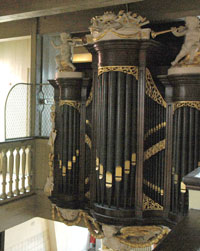 |
Listen to the organ on the first gallery:
The first gallery, opposite the altar, is dominated by the organ which was built especially for the church in 1794 by Hendrik Meyer. His monogram can be seen on the back of the organ. The organ's bellows, which are contained in a large cupboard in the corner. A wooden tube leads air from the bellows to the organ itself. The organ is still played. When the organ is played, the balustrade on the first gallery resonates at certain pitches and some objects displayed in this area are known to ‘walk’. However it is difficult to distinguish if the movement of some objects is related to the organ being played or is due to vibrations caused by visitor movement, or even outside traffic.
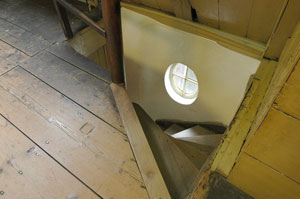 A final steep and narrow staircase leads to the second gallery. Not all the visitors climb to this highest point on the tour, which is not for the fainthearted. This is the only way up and down from the second gallery.
A final steep and narrow staircase leads to the second gallery. Not all the visitors climb to this highest point on the tour, which is not for the fainthearted. This is the only way up and down from the second gallery.
Launch image viewer of the statues in the church
Launch image viewer of church showcases
![]() Collection catalogue (PDF, 5.5MB)
Collection catalogue (PDF, 5.5MB)
![]() Database area reference key (XLS, 571KB)
Database area reference key (XLS, 571KB)
Collection on display
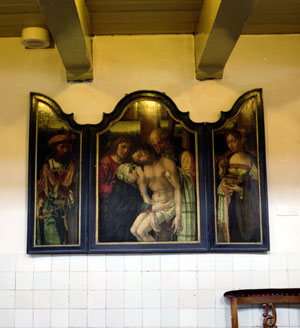 The church is adorned with several interesting objects. Several paintings (both on canvas and on panel) are hung on either side of the church, at floor level and on the first gallery level. Some of these have a direct relation with the church: the painting of Petrus Parmentier, dating back to 1681 depicts the Augustinian priest Petrus Parmentier who served at the church from 1663 to 1671. He was the first priest to rent the attic church.
The church is adorned with several interesting objects. Several paintings (both on canvas and on panel) are hung on either side of the church, at floor level and on the first gallery level. Some of these have a direct relation with the church: the painting of Petrus Parmentier, dating back to 1681 depicts the Augustinian priest Petrus Parmentier who served at the church from 1663 to 1671. He was the first priest to rent the attic church.
On the right you can see the panel painting 'Descent from the Cross' by the studio of Pieter Coecke van Aelst (c. 1535).
There are also several sculptures: a Pietà dating back to 1500; an 18th century glazed earthenware sculpture of Pulpit with Father Brugman (who was a fourteenth-century Franciscan principally known for his oratorical skills. In fact, his talent earned him a place in the Dutch language - a person who ‘talks like Brugman’ can talk the hind legs off a donkey). The two monochrome statues of apostles Peter and Paul in the church are among the most important of the museum collection. They originally came from another clandestine church in Amsterdam.
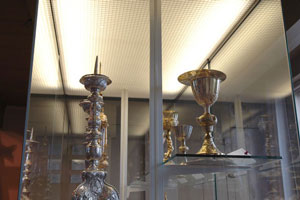 On the first gallery, in the space near the organ, there is a glass showcase with ecclesiastical silverware. The silver objects in the showcase show gradual movement in one direction over time. The showcase is slightly unbalanced and the objects within rock gently when visitors walk in this area.
On the first gallery, in the space near the organ, there is a glass showcase with ecclesiastical silverware. The silver objects in the showcase show gradual movement in one direction over time. The showcase is slightly unbalanced and the objects within rock gently when visitors walk in this area.
Lady chapel
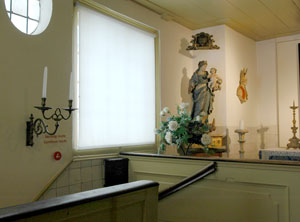 An additional altar dedicated to the Virgin Mary is located behind the main altar of the church. A statue of the Virgin can be seen on the left of the this altar. Standing on the crescent moon holding the infant Christ, the Virgin Mary is crushing a serpent, symbolizing the devil. This colorfully painted lime wood sculpture, carved around 1690, is part of the original inventory of the church. The altar\x92s blue damask antependium (curtain) is woven with symbols of the Virgin (the rose and crown).
An additional altar dedicated to the Virgin Mary is located behind the main altar of the church. A statue of the Virgin can be seen on the left of the this altar. Standing on the crescent moon holding the infant Christ, the Virgin Mary is crushing a serpent, symbolizing the devil. This colorfully painted lime wood sculpture, carved around 1690, is part of the original inventory of the church. The altar\x92s blue damask antependium (curtain) is woven with symbols of the Virgin (the rose and crown).
